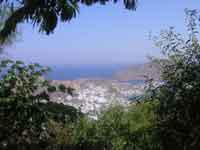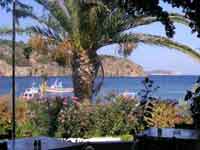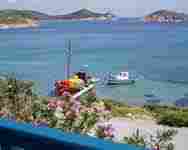.
Administrative Region : North Aegean
Regional unit : Kalymnos
Patmos (Greek, Πάτμος; Italian: Patmo) is a small Greek island in the Aegean Sea. One of the northernmost islands of the Dodecanese complex, it has a population of 2,984 and an area of 34.05 km2 (13.15 sq mi). The highest point is Profitis Ilias, 269 meters above sea level. The Municipality of Patmos, which includes the offshore islands of Arkoi (pop. 54), Marathi (pop. 6), and several uninhabited islets, has a total population of 3,044 (2001 census) [1]and a combined land area of 45.039 km². It is part of the Kalymnos peripheral unit.
Patmos' main communities are Chora (the capital city), and Skala, the only commercial port. Other settlements are Grikou and Kampos. The churches and communities on Patmos are of the Eastern Orthodox tradition. In 1999, the island's historic center Chora, along with the Monastery of Saint John the Theologian and the Cave of the Apocalypse, were declared World Heritage Sites by UNESCO.[2] The monastery was founded by Saint Christodulos.[3] Patmos is also home to the Patmian School, a notable Greek seminary.

St. John the Evangelist on Patmos
Patmos is mentioned in the Christian scriptural Book of Revelation. The book's introduction states that its author, John, was on Patmos when he was given (and recorded) a vision from Jesus. Early Christian tradition identified this writer John of Patmos as John the Apostle, though some modern scholars are uncertain. As such, Patmos is a destination for Christian pilgrimage. Visitors can see the cave where John is said to have received his Revelation (the Cave of the Apocalypse), and several monasteries on the island are dedicated to Saint John.
The current mayor of Patmos is Grigoris Kamposos.

History
John the Apostle on Patmos by Jacopo Vignali.
The beach at Meloi, within walking distance of Skala
The earliest remains of human settlements date to the Middle Bronze Age (ca 2000 BC). They consist of pottery shards from Kastelli, the most important archaeological site so far identified.
Patmos is seldom mentioned by ancient writers. Therefore very little can be conjectured about the earliest inhabitants. In the Classical period, the Patmians prefer to identify themselves as Dorians descending from the families of Argos, Sparta and Epidaurus, further mingling with people of Ionian ancestry.

Skala from Monasteru Agios Ioannis Theologos


Judging from archaeological finds, Kastelli continued to play an important role on the island throughout the Ancient Greek period (ca 750 BC-323 BC).
During the 3rd century BC, in the Hellenistic period, the settlement of Patmos acquired the form of an acropolis with an improved defence through a fortification wall and towers.[4]
After the death of John of Patmos, possibly around 100 AD, a number of Early Christian basilicas were erected on Patmos. Among these was a Grand Royal Basilica in honour of Saint John, built ca 300-350 at the location where the Monastery of Saint John the Theologian stands today.
Early Christian life on Patmos, however, barely survived Muslim raids from the 7th to the 9th century.[CN] During this period, the Grand Basilica was destroyed. In the 11th century, the Byzantine Emperor Alexios I Komnenos gave Reverend Father Christodoulos the complete authority over the island of Patmos, as well as the permission to build a monastery on the island. The construction of the monastery started in 1101.[4][5]
Population was expanded by infusions of Byzantine immigrants fleeing the Fall of Constantinople in 1453, and Cretan immigrants fleeing the fall of Candia in 1669.
The island was controlled by the Ottoman Empire for many years, but it enjoyed certain privileges, mostly related to tax-free trade by the monastery as certified by Ottoman imperial documents held in the Library.
In 1912, in connection with the Turco-Italian War, the Italians occupied all the islands of the Dodecanese, including Patmos. The Italians remained there until 1943, when Nazi Germany took over the island.
In 1945, the Germans left and the island of Patmos remained autonomous until 1948, when it, together with the rest of the Dodecanese Islands, joined the independent Greece.[5]
The birth of Patmos according to Greek mythology
According to a legend within the Greek mythology, the island's original name was "Letois," after the goddess Artemis, daughter of Leto. It was believed that Patmos came into existence thanks to her divine intervention. Mythology tells of how Patmos existed as an island at the bottom of the sea.
Deer-huntress Artemis frequently paid visits to Caria, the mainland across the shore from Patmos, where she had a shrine on Mount Latmos. There, she used to meet up with the moon goddess Selene, who cast her light on the ocean, revealing the sunken island of Patmos.
Selene was always trying to get Artemis to bring the sunken island to the surface and, hence, to life. Selene finally convinced Artemis, who, in turn, elicited her brother Apollo's help, in order to persuade Zeus to allow the island to arise from the sea.
Zeus agreed, and the island emerged from the water. The Sun dried up the land and brought life to it. Gradually, inhabitants from the surrounding areas, including Mount Latmos, settled on the island and named it "Letois" in honour of Artemis.[6]
Government
Illegal immigration
In September 2008, the municipality of Patmos refused landing to a group of undocumented refugees from Afghanistan and Iraq. On the weekend of September 19, 2008, about 133 refugees were rescued. The refugees were taken to Patmos, the nearest municipality, for processing and care. The administration refused them permission to land. Eventually they were sent to the island of Leros where they were processed and given humanitarian aid.[7][8] Local authorities justified their action by contrasting it to alleged practices elsewhere in the EU: "Malta sinks their boats and Italy lets them drown", local leaders claimed.[9]
Health
For emergencies, Patmos has a medical center, with several medical doctors on the premises. When residents require hospitalization beyond the first aid care, they are airlifted out of the island by helicopter (on emergencies) to nearby ones or, if the weather permits, they are transported by the ferry.[CN]
References
^ http://webcache.googleusercontent.com/search?q=cache:7L57lx5DvBYJ:greecetravelog.com/patmos-island-greece/+population+of+patmos+greek&cd=3&hl=en&ct=clnk&gl=us&client=safari&source=www.google.com
^ UNESCO, World Heritage Site #942, webpage:WHC-UNESCO-942.
^ "Patmos". Catholic Encyclopedia. New York: Robert Appleton Company. 1913.
^ a b Patmos – official website History. Retrieved on 2008-09-04.
^ a b Greeka.com – Patmos history. Retrieved on 2008-09-04.
^ Patmos – official website Legendary folk tales and mythology. Retrieved on 2008-09-04.
^ Nylou Editorial
^ Interpress Agency: Refugees Kept At Sea
^ "Η Πάτμος δεν δέχτηκε τους 133 αλλοδαπούς" (in Greek). Kathimerini. 2008-09-23. Retrieved 2008-11-25.
Further reading
Tom Stone: The Summer of My Greek Taverna: A Memoir, Simon & Schuster, New York NY 2003, ISBN 074324771X (Stone brings readers into the tiny Greek island world of Patmos)
|
The Dodecanese Islands Agathonissi | Koubelonisi | Stroggyli | Farmakonisi | Arkoi | Kalovolos | Agreloussa | Anydros Patmou | Patmos | Hiliomodi Patmou | Tragonisi | Arefoussa | Leipsoi | Megalo Aspronisi Leipson | Makry Aspronisi Leipson | Kouloura Leipson | Makronisi Leipson | Halavra | Imia | Fragos | Arhangelos | Faradonesia | Leros | Piganoussa | Pitta | Megalo Glaronisi | Mikro Glaronisi | Kalymnos | Kalolimnos | Kalavros Kalymnou | Telendos | Nero | Safonidi | Plati Pserimou | Pserimos | Levitha | Mavra Levithas | Glaros Kinarou | Kinaros | Kos | Gyali | Nisyros | Pergoussa | Paheia Nisyrou | Kandeloussa | Tilos | Antitilos | Gaidourosnissi Tilou | Seirina | Mesonisi Seirinas | Adelfoi Syrnas Islets | Kounoupoi | Koutsomytis | Hondro | Astypalaia | Fokionissia | Pontikoussa | Symi | Nimos | Marmaras | Kouloundros | Plati Symis | Sesklio | Chalki | Agioi Theodoroi Halkis | Alimia | Makry Halkis | Prasouda | Rhodos | Strogulli Kritinias | Htenies | Karavolas Rodhou | Prasonissi Rodhou | Megalo Sofrano | Mikro Sofrano | Astakida | Kamilonisi | Saria | Karpathos | Kasos | Armathia | Makronissi Kassou | Rho | Kastellorizo (Megisti) | Stroggyli Kastellorizou |
| Ancient Greece
Science, Technology , Medicine , Warfare, , Biographies , Life , Cities/Places/Maps , Arts , Literature , Philosophy ,Olympics, Mythology , History , Images Medieval Greece / Byzantine Empire Science, Technology, Arts, , Warfare , Literature, Biographies, Icons, History Modern Greece Cities, Islands, Regions, Fauna/Flora ,Biographies , History , Warfare, Science/Technology, Literature, Music , Arts , Film/Actors , Sport , Fashion --- |
Retrieved from "http://en.wikipedia.org/"
All text is available under the terms of the GNU Free Documentation License


